#cow urine in India
Explore tagged Tumblr posts
Text
Sacred Cows and Scientific Temper: Weaving Faith, Evidence, and Public Trust
The tale of cow worship in India intertwines faith, tradition, and complex controversy. Dr. Veezhinathan Kamakoti, director of IIT-Madras, stirred this narrative recently. His claims about cow urine’s medicinal properties sparked debates across diverse societal and scientific domains. While deeply rooted in cultural beliefs, such statements demand closer scrutiny and careful reflection.
#cow worship#science and tradition#IIT Madras directors cow views#cow urine benefits#public science responsibility#sacred cows India#caste and cow worship#scientific validation of cow products#faith and science balance#Ambedkar on science and faith#Insights on cow urine controversy#IIT director Dr. Kamakoti endorses cow urine.
0 notes
Note
Please say sike. Please
"Drinking cowpiss is medicinal." This is why India is the tuberculosis capital of the world.
Meanwhile hindublr is out there fighting for their lives trying to prove drinking cowpiss is medicinal 🫠 how are we supposed to take them seriously? Is this what the country has come to?
Anon, please tell me this is a joke and that people aren't on Tumblr actually trying to argue about gaumutra's "medicinal properties". This has to be a joke. Right?!?!?
-Mod S
#hi did you know unpasteurized cow milk can give you tb#as does cow urine#you guys are so stupid#india#hinduism#hindu#lol#desi#important
30 notes
·
View notes
Text
let the left ecosystem do whatever anti india propaganda they wanna do but at the end of the day it's a fact that the country that is respected and holds considerable value in global politics is India and not pakistan. No amount of propaganda is gonna dent that. Call us cow urine drinkers and poopjeets as much as you want but we're not the ones going around the world with a begging bowl
#'free kashmir' go to world court then#we dare you#you'll lost the case on the first day#because we have it in papers#with signature#kashmir LEGALLY belongs to india#*lose
14 notes
·
View notes
Note
Do you know why Indians in particular (and I suppose, new age spiritualists) believe in things like homeopathy or ayurveda(like ashwagandha)? I've always found it so odd, even growing up in india. It's clear that some of these beliefs are marketing schemes, like saying A2 (Indian cows) milk > A1(foreign cows) to the point that they sell A2 cow milk and butter at 10x-20x the price of A1 cow milk. All because of "Vedic" practices (prayers and conducting rituals) of cow rearing. We know that ayurveda especially has no clinical or empirical evidence. It's all anecdotal. But even I was taught to believe that turmeric is a good antioxidant and is great for colds. In reality, only about 2% of turmeric is absorbed by your body. Are indians just more gullible because of Hinduism or is it just willful ignorance because they want to feel some sort of superiority in their spirituality?
Lots of love, thank you for continuing to post!! 💛💛 Hope you're doing well.
A big chunk of it may well be the lack of penetration of criticism and mockery of these superstitions, both for cultural and language reasons.
There's a saying that "sunlight is the best disinfectant." This isn't literally true, it's a metaphor for the notion that exposing ideas to the light of scrutiny, examination and refutation helps to break down and destroy false or bad ideas.
To some extent, the persistence of these superstitions may be that they've not been well exposed to public view to the extent many others have been.
Islam has in its doctrine, the curative and medicinal properties of camel urine. To the extent it's packaged and sold as medicine in the present day solely because in multiple hadiths, Muhammad prescribed camel urine for ailments. People don't know about this, don't believe it or start making excuses about "natural remedies" and the limitations of "western medicine." Even while the World Health Organization calls for people to stop drinking it.
Outside India, there's a certain anti-western chauvinism, coupled with a fetishization of "exotic" cultures. Which is really just the Appeal to Nature and Appeal to Tradition fallacies. But are ripe to be exploited by con artists (e.g. Deepak Chopra) for sale to the credulous who mistake their trendy credulity for "open mindedness." Even though the same people would never be so gullible about superstitions based on Xian mythology.
What this means is that a protective bubble forms around these superstitions because attacking primitive, superstitious nonsense hogwash becomes a "racist" attack on a "culture." You're allowed to - and encouraged to - criticize and attack Xian faith-healing, but not Hindu faith-healing because that's just intolerant of a "culture." Note that this means they want Indian culture to be mired in primitive superstitions.
Internal to India, I think a big part is just that it's so dominant and there isn't the tradition of secularism - separation of church/religion and state - which means religious faith holds more sway. Coupled with more explicit moves in recent years to mirror Islam in offence and fragility regarding "blasphemy" - see the whole "Sexy Kali" thing, for example.
In contrast, in the US, there's been legal challenges mounted against homeopathy as fraud and false advertising under consumer protection laws. If there's no evidence of efficacy, government safety organizations in countries like the US, UK, Canada, Australia and New Zealand either don't allow a product to be sold as "medicinal," or don't allow it to be sold at all.
I don't know enough about Indian law to know how robust Indian safety or consumer laws are in terms of leveraging them to call out the same kinds of fraud, but what you're saying about the milk suggests they might not be. It's essentially a claim of "magic milk," given there could be no scientific test that such a claim could survive.
So, there's this absence of pressure from both internal and external. And as we know from evolution, it's pressure which drives change.
People need to be willing to treat Indian and Hindu superstitions the same as they treat Xian superstitions and other unscientific bunk, rejecting attacks on the basis of "racism" or "blasphemy" or "intolerance" or all the usual shit. But I think there also needs to be avenues culturally and legally within India to start challenging the assertions being made. I don't know enough about Indian society or culture to know how much of a superiority complex may be at play, but there is likely an element of ignorance, not necessarily wilful, just regular old ignorance, because of the pervasiveness and persistence of these ideas.
Of course, people are still free to believe stupid shit. But that doesn't mean it should get special, elevated status or be allowed to commit acts of rampant fraud.
11 notes
·
View notes
Text
Soma … exacts self-discipline of the priests, a long initiation and training: it is, for proper exploitation, an affair of a priestly elite. But the possible role of Stropharia cubensis growing in the dung of cattle in the lives of the lower orders remains to this day wholly unexplored. Is S. cubensis responsible for the elevation of the cow to a sacred status? And for the inclusion of the urine and dung of cows in the pancagavya (the Vedic sacrifice)? And was that a contributing reason for abandoning Soma? Given the ecological conditions prevailing in the Indus Valley and Kashmir, only a few of the Indo-Europeans could know by personal experience the secret of the Divine Herb. The cult of Soma must have been shaped by the peculiar circumstances prevailing in the area, but ultimately those circumstances must have doomed that cult. Today it lives on in India only as an intense and glowing memory of an ancient rite.
— Terence McKenna, Food of the Gods
2 notes
·
View notes
Text
Are Animal Farms Causing Air Pollution? A Closer Examination of Livestock's Invisibility

While browsing various sites, we came across a question on Quora: “Should rise in large intensive poultry units be seen as a driver of air pollution?”. Mostly when we think about air pollution, we envision traffic-filled roadways, factory smokestacks, or trash being burned outdoors. Seldom do we think about the role of animal agriculture—yet livestock farms are a major and frequently underestimated source of air pollution, particularly in rural and peri-urban regions.
The environmental narrative on animal agriculture has largely centered on land use, water usage, and greenhouse gases such as methane. Yet, as air quality professionals, it's critical we emphasize the role animal farms play in regional and local air pollution, specifically from ammonia, particulate matter, methane, and VOCs.
In this blog, we break down the suspicion related to emissions by farm animals, their health and environmental consequences, and solutions to cut down emissions, giving an in-depth insight into this not-so-well-known air pollution source.
What Occurs in an Animal Farm?
Animal farms, viz, poultry, cattle, pig, or mixed livestock farms, are intricate systems where animals are bred for meat, milk, or other commodities. These farms produce vast amounts of:
Animal waste (urine and feces)
Feed dust and bedding material
Manure fertilizers
Methane from digestion and manure storage
If not well managed or accumulated in high concentration, these organic by-products are a source of airborne pollutants.
Major Air Pollutants of Animal Farms
1. Ammonia (NH₃)
Urea in animal urine decomposes into ammonia when it comes into contact with enzymes in faeces or soil.
Ammonia is an irritating, pungent gas that impacts the respiratory system, eyes, and skin.
Ammonia combines with acidic substances in the air (such as nitrogen oxides or sulphur dioxide) to create secondary PM2.5, a serious health issue.
India ranks among the highest emitters of ammonia in the world, the majority coming from animal farming and agriculture. Livestock waste contributes more than 50% of ammonia emissions worldwide, reports the FAO.
2. Particulate Matter (PM10 and PM2.5)
Emitted from animal feed dust, dried manure, bedding material, and manure management practices.
Respiratory diseases, asthma, and cardiovascular risks are caused by exposure to particulate matter.
As mentioned above, ammonia is responsible for creating secondary particulate matter, thus, animal farms are an indirect source of PM2.5.
Experiments conducted in North India have revealed spikes in localized PM levels near large dairy or poultry farms, particularly in dry periods when waste dries out and disperses readily.
3. Methane (CH₄)
It is released during enteric fermentation in ruminants such as cows and buffalo, and during anaerobic decomposition of manure.
Methane is an extremely powerful greenhouse gas—more than 80 times more potent than CO₂ over a 20-year time frame. It also indirectly causes ground-level ozone creation, which is both a pollutant and a greenhouse gas.
Although methane is not an injurious pollutant in the traditional sense, it contributes to climate-driven air quality changes, like elevated ozone creation and heatwaves, which aggravate urban smog.
4. Volatile Organic Compounds (VOCs) and Odorous Compounds
Manure, silage (fermented feed), and animal digestion emit VOCs such as hydrogen sulfide, phenols, and amines.
These substances produce nausea, headaches, and respiratory irritation, especially in poorly ventilated spaces.
VOCs are precursors to ozone and PM formation in the atmosphere.
Even low levels of hydrogen sulphide can be toxic and can go unnoticed unless there is air monitoring.
Who is Affected?
Although such emissions tend to happen in rural areas, air pollution does not know boundaries. Here is how various stakeholders are impacted:
Farm workers: Chronic respiratory disease, eye and skin irritation, and increased asthma cases result from prolonged exposure.
Local residents: Those who live within 1–5 km of large farms can see air quality degraded, particularly during hot, dry periods.
Urban residents: Ammonia and methane emissions from local livestock operations can blow into cities, making regional PM2.5 and ozone formation.
Environment: Acid rain from ammonia and sulphur compounds changes soil chemistry, damages forests, and injures crops.
It’s always better to be aware of the impacts of your environment and the pollutants present. Initiatives like Respirer provide real-time monitoring solutions to keep in check the pollutant level and take measures accordingly.
Policy and Research Insights
The connection between animal farming and air pollution is internationally well-documented, but policy action remains limited.A fewexamples globally are:
The Netherlands: Cut ammonia emissions more than 60% since the 1990s through improved manure management, low-emission livestock housing, and rigorous nitrogen controls.
United States: The EPA's National Air Emissions Monitoring Study (NAEMS) conducted studies on animal feeding operations to guide regulatory formulation.
China: Implemented guidelines on better waste management from livestock to reduce ammonia and methane emissions in major agricultural areas.
In India, though, animal farm air pollution is not regulated directly. The attention has largely been towards industrial and vehicle sources, with agricultural emissions, like ammonia, under-monitored.
What Can Be Done to Cut Emissions?
Reducing emissions from animal farms needs science-supported, scalable solutions:
1. Better Waste Management
Utilizing anaerobic digesters to process manure as biogas.
Manure storage should be covered to minimize ammonia and methane emissions.
Composting with carbon-rich substrates, such as straw to stabilize the emissions.
2. Feed and nutrition optimization
Modifying animal feeds to minimize nitrogen excretion.
Supplementing with feed additives that lower enteric methane.
3. Low-Emission Housing
Ventilation systems are installed correctly.
Bedding materials with dust and VOC suppressants.
4. Monitoring of Air Quality
Install local sensors to monitor ammonia, PM2.5, and methane in proximity to farms.
Utilize this information to inform local planning and buffer zone development.
Platforms such as Respirer can assist rural communities and policymakers in monitoring pollutant levels and making informed decisions.
Conclusion: Don't ignore the Animal farm Footprint
Animal farms contribute significantly to food security, livelihoods, and economies. But as our knowledge of air pollution becomes more developed, it's crucial that we acknowledge livestock farming as a genuine cause of poor air quality, particularly through ammonia and methane emissions.
Solutions do exist. Many are already implemented in countries with more stringent environmental regulations. What we require in India and elsewhere, it is awareness, investment in cleaner practices, and policy innovation that enlists agriculture into the circle of air quality management.
Respirer provides such solutions to help the government and policymakers keep tabs on the air pollutant levels. As air quality professionals, we feel it's time to extend the pollution story beyond fuel and factories. Every sector contributes to the air we breathe, and only then will there be enduring change if we behave accordingly.
#air pollution#air quality#aqi#airpollutants#healthcare#clean air#respirer living sciences#pm2.5#livestock#cows#animal farm
1 note
·
View note
Text
India’s ₹598 Crore Gamble on Cow Urine and Dung Research: A Wasteful Pursuit?
India’s ₹598 Crore Gamble on Cow Urine and Dung Research: A Wasteful Pursuit? 🔗 https://medium.com/@therationalist/indias-598-crore-gamble-on-cow-urine-and-dung-research-a-wasteful-pursuit-5a8cf0a44259
0 notes
Text
5 Benefits of Gir Cow Farming

Gir cow farming offers numerous benefits for farmers and the environment. Gir cows are known for their high-quality A2 milk, which is healthier and easier to digest than regular milk. They are naturally disease-resistant and require less medical intervention. Their dung and urine are excellent for organic farming and biogas production. Gir cows adapt well to Indian climatic conditions, reducing maintenance costs. They also play a key role in sustainable agriculture by improving soil fertility. With increasing demand for organic dairy products, Gir cow farming provides a profitable, eco-friendly, and culturally significant livelihood option for rural communities in India. Looking to start Gir cow farming in India? Find the right supplier easily at Dairy Mitra – your trusted platform for all dairy farming needs. We connect you with verified and reliable Gir cow suppliers across the country, ensuring quality and authenticity. Join us today and take the first step towards successful Gir cow farming with the best suppliers in India at your fingertips.
Call: +91-7015165894 Mail: [email protected]
#Gir Cow Suppliers in India#Best Gir Cow Suppliers in India#Top Gir Cow Suppliers in India#Gir Cow Traders in India#Best Gir Cow Traders in India#Top Gir Cow Traders in India#Gir Cow Supplier in Karnal#Gir Cow in Karnal
0 notes
Text
The Benefits of Cow Puja: A Spiritual and Holistic Perspective
Introduction
Cow Puja, a traditional practice in many cultures, particularly in India, holds deep spiritual, cultural, and ecological significance. Revering the cow as a symbol of abundance, purity, and sustenance, this ritual has been celebrated for centuries. Beyond its spiritual value, Cow Puja offers several tangible and intangible benefits that touch upon various aspects of life.
1. Spiritual Benefits
Cultivating Gratitude: Cow Puja serves as an act of gratitude for the cow's contributions, including milk, dung, and urine, which have numerous uses in daily life.
Enhancing Positivity: Worshipping the cow is believed to purify the environment and attract positive energies.
Connection to Divinity: In Hindu culture, the cow is considered sacred, associated with deities like Lord Krishna and Kamadhenu, the wish-fulfilling cow. Performing puja strengthens one’s spiritual connection.
2. Cultural and Social Benefits
Preservation of Heritage: Cow Puja helps in sustaining ancient traditions and passing them on to future generations.
Community Bonding: Celebrating Cow Puja fosters unity and togetherness among families and communities.
3. Ecological Benefits
Environmental Purification: Cow dung and urine are considered natural purifiers. During the puja, their use in rituals helps purify the surroundings.
Sustainable Farming Practices: Cow dung and urine are used as bio-fertilizers, reducing dependence on chemical fertilizers and promoting organic farming.
4. Emotional and Psychological Benefits
Stress Relief: Engaging in rituals like Cow Puja can induce calmness and reduce stress.
Instilling Compassion: Reverence for the cow encourages empathy and kindness towards animals.
5. Health Benefits
Use of Panchagavya: Products derived from the cow (milk, ghee, curd, urine, and dung) are used in Ayurveda for their healing properties.
Boosting Immunity: The consumption of cow-derived products, such as A2 milk from indigenous breeds, is believed to enhance health.
Conclusion
Cow Puja is more than a ritual; it’s a holistic practice with spiritual, ecological, and societal benefits. Embracing this tradition not only honors a sacred animal but also promotes a lifestyle of gratitude, sustainability, and harmony with nature. By performing Cow Puja, individuals reconnect with their roots and contribute to a balanced and peaceful existence.
Foer more info:-
cow puja benefits
0 notes
Text
Know Your Soil: Fertilization Tips for Every Soil Type
India is a country with a rich farming tradition. Here, we have many types of soil that help grow different crops. By using the right farming methods and natural (jaivik) fertilizers for each soil type, farmers can grow more crops and keep the soil healthy for many years. This way, farming becomes better, and the land stays good for future generations.
So how can you improve fertility to your farm soil?
Let’s see nature of soil and its fertilization tips:
Black soil or Regur or cotton soil
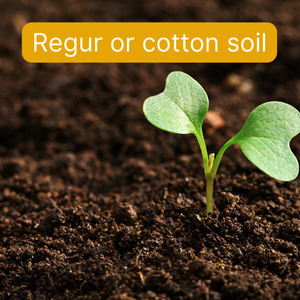
Black soils are characterised by a thick, dark-coloured soil and it is rich in humus. Black soils are extremely fertile and can produce high agricultural yields due to their elevated moisture storage capacity. Black soils are rich in iron, lime, calcium, potassium, aluminum and magnesium.
Crops: Cotton, Jowar, Wheat, Groundnut,Tobacco.
Deficiency: Nitrogen, Phosphorus, Organic matter.
Tips to fertilise black soil
Avoid Over-Watering: Black soil retains moisture well; over-irrigation can lead to waterlogging.
Crop-Specific Fertilization: Tailor fertilizer applications to the specific nutrient needs of crops like cotton, soybeans, or cereals.
pH Management: If soil pH exceeds 8, Use organic materials like mulch, pine needles, sphagnum peat moss, compost, and coffee grounds. For lower alkalinity.
Farmyard Manure (FYM): Enriches organic matter and microbial activity.
Vermicompost: Improves soil structure and nutrient availability.
Green Manure Crops: Legumes like gomutra or sun hemp fix nitrogen and improve organic content.
Compost:Homemade or commercial compost provides a balanced nutrient supply.
Read More:Vermicomposting
Red soil and Yellow soil

Red soil is rich in iron oxide, giving it a characteristic reddish color. When red soil is fully hydrated it becomes yellow in colour. It has a sandy to loamy texture, good drainage, and low natural fertility. Its pH value varies from 4 to 8.
Crops: Wheat, Pulses, Millets, Potatoes, Vegetables. Deficiency: Limited organic matter and low nitrogen, phosphorus, humus and potassium levels. Proper fertilization can greatly enhance its productivity.
Tips to fertilise Red soil?
Erosion Control: Use contour farming, mulching, or terracing to prevent topsoil loss.
Moisture Management: Use cow dung to retain moisture, as red soil drains quickly.
pH Balance: If the soil is highly acidic, apply lime to neutralize acidity.
Farmyard Manure (FYM): Add 8–10 tons/acre to improve organic matter.
Vermicompost: Improves soil texture and adds slow-releasing nutrients.
Green Manuring: Leguminous crops like gomutra or dhaincha (one type of plant)fix nitrogen and enrich the soil.
Alluvial soil
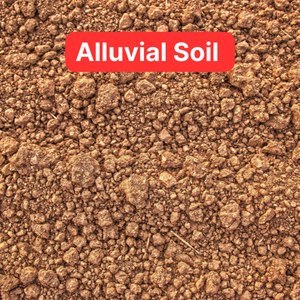
Alluvial soil is fertile soil deposited by rivers, making it one of the most agriculturally productive soils. It is found extensively in river basins and plains. Alluvial soils are suitable for agriculture because they are rich in minerals like potash, phosphoric acid, and lime. Crops: Rice, Wheat, Sugarcane, Tobacco, Maize, Cotton, Soybean, Jute, Oilseeds, Fruits and vegetables.
Deficiency: Nitrogen, Humus, and Organic matter
Tips to fertilise Alluvial soil?
Crop Rotation: Alternate between nitrogen-depleting crops (e.g., rice) and nitrogen-fixing crops (e.g., legumes).
Erosion Control: Prevent soil erosion by planting cover crops or using mulching techniques.
Irrigation Management: Leverage the soil’s good water retention but avoid overwatering sandy areas.
Soil Testing: Perform regular soil tests to ensure appropriate fertilization based on nutrient levels.
Fish meal: Rich in nitrogen, phosphorus, and trace elements like calcium, magnesium, and iron.apply 100–150 kg per acre, especially for crops like vegetables, rice, and oilseeds.
Cow Dung and Cow Urine: Cow dung provides a balanced mix of nutrients and organic matter.Cow urine acts as a natural growth stimulant, improving soil fertility and pest resistance.
Desert soil or arid soil

Desert soil is found in arid and semi-arid regions where rainfall is minimal. It has unique characteristics that limit its fertility, but with proper management, it can support specific vegetation types and even agriculture.It also has high levels of calcium carbonate and phosphate.
Crops: Barjara, Jowar, Lentils, Dates, Figs, Oilseeds.
Deficiency: Low moisture, nitrogen, organic matter and other elements like Mg, k, Fe etc.
Tips to fertilise Desert soil?
Rain water harvesting: Store rainwater to irrigate and supplement soil moisture.
Drip Fertigation: Apply water-soluble fertilizers through drip irrigation to reduce wastage and improve nutrient uptake.
Mulching: Cover soil with organic mulch (Organic residues like date palm leaves or other desert vegetation) to conserve moisture, reduce evaporation, and improve nutrient availability.
Crop rotation: Alternate cereal crops with legumes to improve nitrogen content.
Agroforestry: Plant drought-tolerant trees (e.g., Prosopis, Acacia) to enhance soil fertility and reduce erosion.
Soil testing: Conduct soil analysis to identify deficiencies and tailor fertilization accordingly.
Animal-Based Fertilizers: Camel dung, sheep manure, or goat manure (locally available in desert regions).
Peaty soil

Peaty soil is a type of soil that contains a high percentage of organic matter and is typically found in waterlogged and marshy areas. It is dark in color, soft, and spongy due to the accumulation of decomposed plant material over time.
Crops: Rice, Oats, Peas, Lentils, Grams (chickpeas), Soybeans, Barriers.
Deficiency: Potassium, Micronutrient, Magnesium, Calcium, Nitrogen.
Tips to fertilise Peaty soil?
Lime application: Use lime to neutralize acidity and improve pH.
Crop selection: Grow acidic tolerant crops like tea, barriers and root vegetables or crops that thrive in wet conditions, such as paddy rice.
Wood ash: Supplies potassium and reduces acidity.
Bio-fertilizer: Use nitrogen-fixing bacteria(e.g., Rhizobium) and phosphate-solubilizing bacteria to enhance nutrient availability. you can also use Advance jivamrut.
Conclusion
Soil is a living system like any other organism cell develops and undergoes degradation. Soil degradation happens due to soil erosion. If treated in time, it can be saved from degradation and harvested again. choose right fertilization to improve your soil quality. In this blog we can apply tips and make soil fertile.
0 notes
Text
When Science Meets Faith: The Curious Case of Dr. Kamakoti
Dr. Teezhinathan Kamakoti, director of IIT-Madras, is a respected computer scientist. He leads one of India’s most prestigious scientific institutions, known globally for excellence in technology and research. Yet, his recent statements have stirred an unexpected debate.
At a gathering organized by Go Samrakshana Sala in Chennai, Kamakoti shared his views on cow urine. He claimed it has medicinal properties, including potential cures for cancer and other chronic diseases. These remarks, made during a speech promoting indigenous cow breeds, sparked widespread discussions among the public and scientific communities.
Kamakoti’s love for indigenous cows, particularly breeds like Gir and Sahiwal, is deeply personal. However, his position as IIT director gives his words additional weight. Many believe his statements blurred the line between science and faith, raising concerns about their scientific validity. Read more
#Dr. Kamakoti#IIT-Madras director#cow urine medicinal properties#science vs faith#indigenous cows#National Cow Science Research Programme#blending tradition and science#science communication#unverified scientific claims#cultural beliefs and science#Insights on mixing science with religion
1 note
·
View note
Text
Cow Welfare: UP Government's Scheme for Goshalas Development
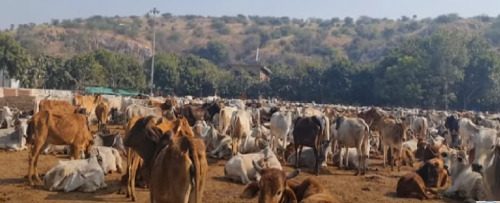
Greetings Goshalas are important in India. Goshalas, also known as cow shelters, are an important part of rural Indian culture. They support the sustainability of agriculture while giving cows, especially stray and non-productive ones, a safe refuge.
The emphasis of the UP government on cow welfare The Uttar Pradesh government launched a special program for the development of goshalas as part of its proactive efforts to advance cow care. In addition to promoting rural livelihoods, this effort seeks to protect cow welfare.
The Scheme's Overview Goals of the Plan The plan aims to:
Ensure that stray and unproductive cows receive the required care and housing. To strengthen the rural economy, promote items made from cows. Make careful you use organic fertilizers to ensure sustainable farming methods. Allotment of Budget Significant funding has been allotted by the UP government for this program, guaranteeing adequate cash for goshala operating needs, healthcare, and infrastructure development.
The Initiative's Principal Elements construction of contemporary cow shelters. frequent veterinarian treatment and vaccinations. encouragement of the production of cow-based goods, including organic fertilizers. The Scheme's Advantages Better Care and Health for Cows The program makes sure cows are healthier and live longer by providing them with adequate housing, consistent nutrition, and medical attention.
Strengthening of the Rural Economy The program encourages the development of cow-based goods, such as methane and fertilizers, giving rural communities new sources of revenue.
Ecological Resource Utilization The use of cow pee and dung to make organic insect repellents and fertilizers lessens reliance on chemical substitutes.
Important Elements of the Plan: Infrastructure Development, Shelter Construction, and Upkeep Building well-equipped shelters that shield cows from harsh weather and offer plenty of room for grazing is a key component of the plan.
Feeding Facilities A consistent supply of wholesome cow feed, such as green fodder and supplements high in minerals, is given special consideration.
Medical Attention for Cattle Vaccination Campaigns To improve the general health of cattle and avoid illnesses, regular vaccination campaigns are planned.
Veterinary Care Services To offer routine health examinations and on-site medical support, mobile veterinarian units are sent out.
Product Development Based on Cows Fertilizers Made of Organic Materials In addition to helping farmers, the program stimulates the creation of organic compost from cow manure, which supports environmentally sustainable methods.
Urine-Based Products and Cow Dung The development of goods like bug repellents, floor cleaners, and biogas gives the goshalas access to new sources of income.
Effect on the Creation of Employment in Rural Communities In Goshalas, the program generates employment for caregivers, veterinarians, and people who process items made from cows.
Boosting of Regional Ecosystems Soil fertility and biodiversity are restored by the project, which encourages organic farming and lessens reliance on chemicals.
Implementation Challenges: Limited Resources in Remote Areas A lack of competent workers and insufficient financing are two issues that certain rural regions confront, which hinders the scheme's efficient implementation.
Issues with Monitoring and Transparency Effective scheme implementation still faces major challenges in maintaining openness and consistent oversight of finances and operations.
How to Effectively Implement It Community Participation Accountability and improved resource use are ensured when local communities are involved in goshala management.
Utilizing Technology to Keep an Eye on Digital technologies may monitor the development of cow-based goods, healthcare services, and the distribution of funds.
Staff members at Goshala receive regular training that enhances their abilities in resource management, product creation, and cow care.
In conclusion, It is admirable that the UP Government is fostering sustainable rural livelihoods and enhancing cow welfare through the Goshala Development Scheme. While maintaining the traditional value of cows in India, this program has the potential to revolutionize rural economies by concentrating on infrastructure, healthcare, and cow-based industries.
0 notes
Text
Anti hindu Nehru family nailed the last perek by declaring India a secularist.
Nehru daughter could have created a new state for persecuted Bangladeshi Hindus in 1971 . She didn't.
Now time to change the mistake.
Will modi do?? Don't know. So far he's afraid of USA deep state and reticent.
He knows Yunus has deep link in USA.
Meanwhile Hindus in bangladesh are in grave danger facing ethnic cleansing. But USA, EU don't take it seriously, cause Hindus drink cow urine, worship cows etc etc. Hindus are subhuman, so hindu plights are not their concern.
No end of misery for Hindus in sight.
0 notes
Text
How a Dairy Farming Project Report Ensures Success in Dairy Business

Dairy farming is one of the most promising business opportunities in India. With the rising demand for milk and dairy products, venturing into this field can be highly rewarding. However, starting a dairy farm requires proper planning and execution. A Dairy Farming Project Report plays an important role in outlining every detail of the business, helping entrepreneurs make informed decisions.
This blog provides an insightful overview of preparing a project report, along with the essentials of starting a dairy farm business.
What is a Dairy Farming Project Report
A Dairy Farming Project Report is a detailed document that provides comprehensive information about the feasibility, cost analysis, and profitability of starting a dairy farm. It includes essential aspects like:
Initial Investment: Land, cattle, infrastructure, and equipment.
Operational Costs: Feed, labor, medical care, and utilities.
Revenue Generation: Milk production, sales of by-products like cow dung and urine, and breeding services.
With a well-structured project report, entrepreneurs can secure bank loans and government subsidies, ensuring a smooth start to their dairy farming business.
Components of a Dairy Farming Business Plan
1. Selection of Dairy Cows
The success of your dairy farm largely depends on the quality of the cows. Breeds like Holstein Friesian, Gir, Sahiwal, and Jersey are popular in India due to their high milk production. Selecting healthy cows with good lactation cycles is essential to maximize output.
2. Farm Infrastructure
A well-structured dairy farm should include:
Cow sheds with proper ventilation and cleanliness.
Feed storage areas for grains and fodder.
Milk collection rooms equipped with chilling tanks. Investing in modern equipment like automated milking machines can boost efficiency.
3. Feed and Nutrition Management
Balanced nutrition ensures better health and productivity of dairy cows. A mix of green fodder, dry fodder, and concentrated feed is ideal. Regularly monitoring the nutritional intake of cows is crucial for maintaining consistent milk production.
4. Healthcare and Maintenance
Veterinary care is a vital part of a dairy farm business. Periodic vaccinations, routine check-ups, and maintaining hygiene prevent diseases and ensure the longevity of dairy cows.
5. Marketing and Sales Strategy
Once your dairy farm is operational, an effective marketing plan is needed to sell milk and dairy products. Partnering with local vendors, supermarkets, and cooperatives can help establish a reliable customer base.
Dairy Farming in India: Opportunities and Challenges
Opportunities
India is the largest milk producer globally, with a high domestic demand for milk and its by-products. The government also provides subsidies and schemes to support the dairy farming business, such as NABARD loans and the Rashtriya Gokul Mission.
Challenges
Some common challenges include fluctuating milk prices, high feed costs, and limited access to advanced technology. However, with proper planning and efficient management, these hurdles can be overcome.
,
Steps to Prepare a Dairy Farming Project Report
Introduction: Define your objectives and vision for the dairy farm.
Market Analysis: Research local demand, competition, and trends in the dairy industry.
Financial Plan: Include details on capital investment, operational costs, and projected earnings.
Risk Analysis: Identify potential risks and mitigation strategies.
Implementation Plan: Outline the timeline for setting up the farm and achieving milestones.
A well-prepared Dairy Farming Project Report provides clarity and attracts investors and financial institutions.
Conclusion
Starting a dairy farming business is lucrative, especially in India, where dairy products are a staple. With a detailed Dairy Farming Project Report, entrepreneurs can plan every aspect of their business efficiently, ensuring long-term success.
Aspiring dairy farmers can overcome challenges and establish a profitable business by understanding the essentials like cow selection, infrastructure, feed management, and marketing strategies.
With the right approach, dairy farming in India can pave the way for financial growth and contribute to the agricultural economy.
0 notes
Text
India’s Number One Brand: Why Gavyaveda Leads the Way in Ayurvedic Wellness

India has long been the birthplace of Ayurveda, an ancient system of healing that harmonizes the body, mind, and spirit through nature's finest offerings. In today’s world, where wellness trends come and go, one brand has emerged as a shining beacon of trust, purity, and authenticity—Gavyaveda. Proudly rooted in the wisdom of Ayurveda, Gavyaveda has rightfully earned its place as India’s No. 1 brand for Ayurvedic wellness. Let’s dive deeper into why this brand stands at the pinnacle of health and wellness today.
A Legacy of Purity and Tradition
At the heart of Gavyaveda lies its unwavering commitment to authenticity. Each product is crafted using traditional Ayurvedic principles, blending the purest ingredients derived from nature. The brand takes inspiration from time-honored formulations, ensuring that its products remain true to ancient wellness practices while catering to modern lifestyles.
Unlike brands that merely market the term "Ayurvedic," Gavyaveda is deeply invested in the authenticity of the process. They work directly with farmers who are custodians of ancient cow-herding traditions, ensuring that all ingredients, particularly from Panchgavya (cow products like milk, ghee, curd, urine, and dung), are sustainably sourced.
A Commitment to Sustainability
In a world facing environmental challenges, Gavyaveda has championed a sustainable approach to Ayurvedic wellness. The brand follows eco-friendly practices in sourcing ingredients and packaging. It deeply values cows as sacred beings, ensuring they are treated humanely in their natural environments. Their Panchgavya-based products, such as ghee, dhoop, and soaps, stem from this philosophy of respecting the earth and its creatures.
This devotion to sustainability extends to every product in their portfolio, making Gavyaveda a pioneer in eco-conscious wellness. Whether it's the biodegradable packaging or the organic farms from which they source their ingredients, Gavyaveda is more than just a brand—it’s a movement toward mindful living.
Products Rooted in Healing
What truly sets Gavyaveda apart is the sheer range and effectiveness of its product line. Gavyaveda offers everything from skincare and dental care to digestive health solutions, ensuring that every aspect of one’s well-being is nurtured. Some standout products include:
Gavyaveda Suvarnaprashan: A powerful immunity-boosting supplement made from cow-derived ingredients and infused with the ancient wisdom of Ayurveda. Suvarnaprashan has been trusted for centuries to enhance cognitive function and build resilience, particularly in children.
Gavyaveda Pure Ghee: Ghee is the essence of Indian cuisine and Ayurveda. Gavyaveda’s pure cow ghee is known for its unparalleled purity, aiding digestion, boosting immunity, and serving as a powerful antioxidant.
Gavyaveda Panchgavya Gugal Nazar Rakshak Dhoop: With ingredients like guggul and pure cow-derived materials, this incense helps purify the air while providing spiritual protection. It is particularly effective in cleansing negative energies.
Gavyaveda Activated Charcoal Manjan: Combining the power of activated charcoal with cow-derived ingredients, this tooth powder ensures oral hygiene and detoxification in one go.
These products are not only effective but also represent a deep understanding of how to combine ancient Ayurvedic ingredients with modern needs, ensuring Gavyaveda’s place as the trusted wellness partner for millions.
Trusted by Billions
The reason Gavyaveda resonates with billions worldwide is simple: it delivers results without compromising on purity. In a market filled with synthetic alternatives and diluted promises, Gavyaveda has maintained an unwavering focus on the consumer’s well-being. From the ingredients to the packaging, every element is designed to promote good health and balance.
Consumers trust Gavyaveda because the brand embodies more than just products—it represents a way of life that encourages holistic health. Whether you’re looking to strengthen your immunity, detoxify your body, or rejuvenate your skin, Gavyaveda’s extensive range of Ayurvedic products offers something for everyone.
The Future of Wellness
As wellness continues to evolve, Gavyaveda remains at the forefront by embracing innovation without losing sight of its roots. The brand’s research and development teams work tirelessly to ensure each new product meets the highest standards of quality while maintaining the integrity of ancient Ayurvedic traditions.
Furthermore, Gavyaveda continues to expand its product line, introducing innovative offerings that cater to the ever-growing global interest in Ayurveda. As it reaches new markets and attracts new generations of health-conscious individuals, one thing remains certain: Gavyaveda is not just India’s No. 1 Ayurvedic brand—it is a global leader in wellness.
gavyaveda.com
0 notes
Text
Shri Venkateshwara University celebrated World Food day by hosting a seminar focused on promoting organic farming techniques.






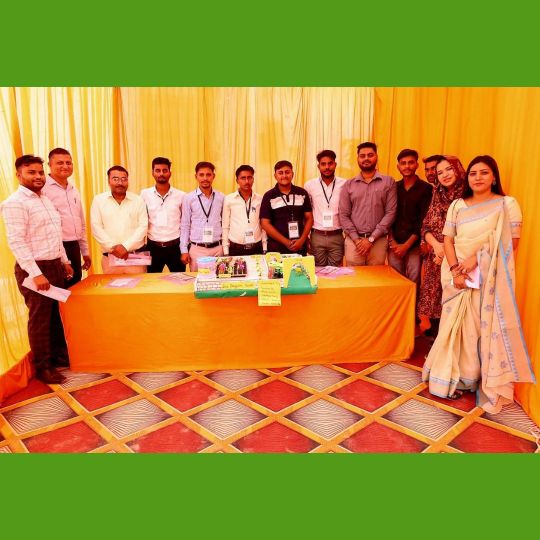
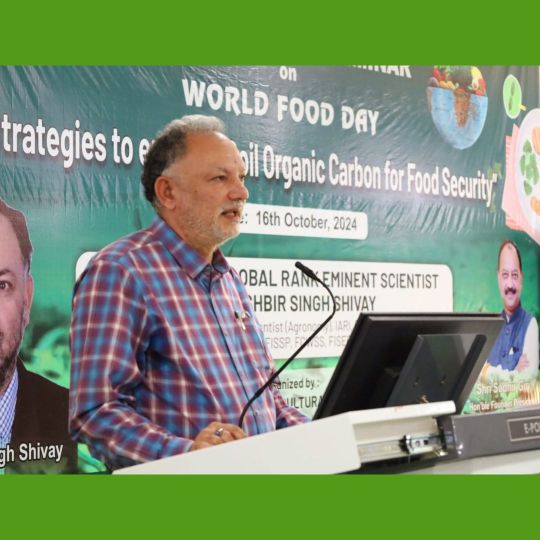






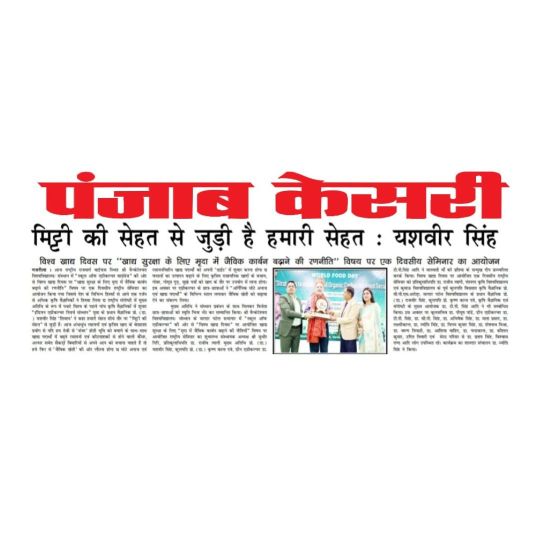
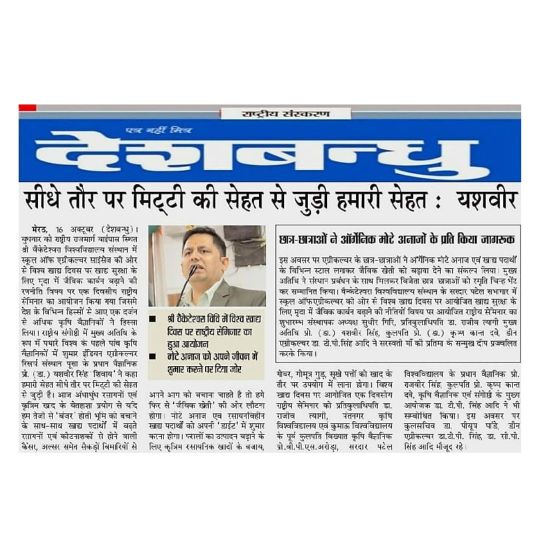
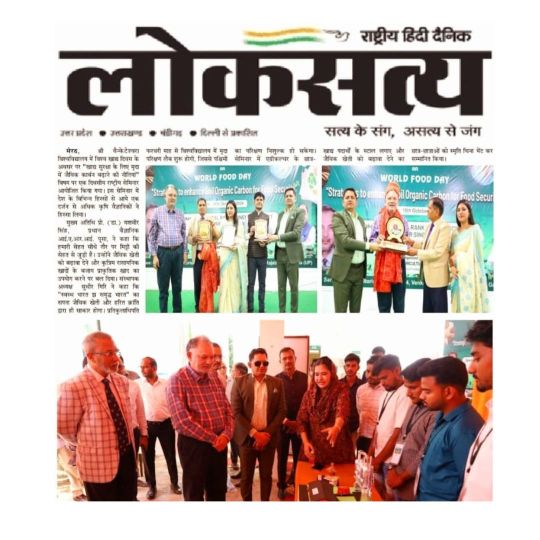
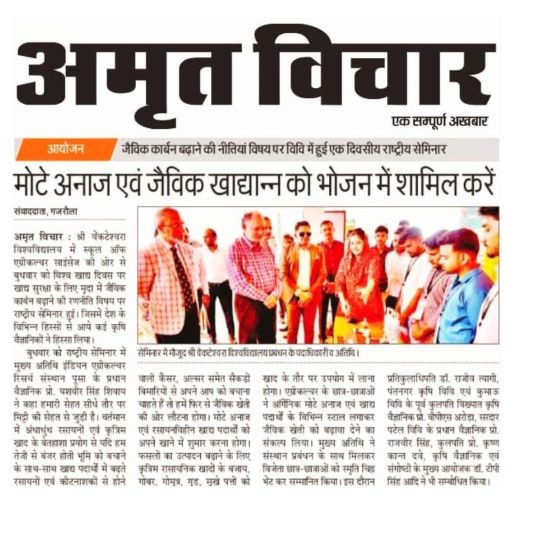
On the occasion of World Food day, Shri Venkateshwara University/Institute organized a seminar on the topic ‘Strategies to enhance soil organic carbon for food security ‘
The School of Agriculture Sciences hosted the 1 day national seminar that saw the participation of over a dozen agriculture scientists from all over the country.
Dr Yashbir Singh Shivay, Principal Scientist IARI Pusa & among the top 5 agriculture scientists in the world, was the Chief Guest at the event.
The Venkateshwara Group Founder President Dr Sudhir Giri, Pro Chancellor Dr Rajeev Tyagi, & the CG Dr Yashbir Singh inaugurated the event by lighting a lamp to Goddess Saraswati.
The VC Dr Krishna Kant Dave & the Agriculture Dean Dr TP Singh joined them to unveil the seminar on strategies to enhance soil organic carbon for food security.
The Agriculture students vowed to promote organic farming by showcasing various stalls about organic millets & food items.
The CG, along with the management, felicitated the winners by presenting them a memento for their excellent models promoting organic farming techniques.
The Venkateshwara Group Founder President Dr Sudhir Giri reiterated we can realize the dream of a Healthy India- Prosperous India through organic farming & green revolution only.
The Chief Guest, Dr Yashbir Singh Shivay, asserted our health primarily depends on the health of the soil.
Soil fertility is declining because of the unregulated use of chemical fertilizers. This poses health risks like cancer, ulcers, and other diseases caused by continuous chemical and fertilizer use in food.
To address this, a transition back to organic farming is needed to preserve soil fertility and protect our health.
We should include millets and chemical free food ingredients in our diet. To increase the yield of crops, we should replace chemical fertilizers with organic manure prepared from cow dung, urine, jaggery & dried leaves.
Dr Rajeev Tyagi, the Pro Chancellor, highlighted that farmers in UP west can avail free soil testing at Venkateshwara starting from February through the newly established Soil Testing Lab.
The seminar was addressed by several distinguished individuals. These included the Pro Chancellor, Dr. Rajeev Tyagi, former VC of Pantnagar Agriculture University and Kumaun University, Dr. VPS Arora.
Also speaking at the seminar were Principal Scientist of SPU, Dr. Yashveer Singh, VC, Dr. Krishna Kant Dave, and the Chief Organizer, Dr. TP Singh.
Those present included the Registrar Dr Piyush Pandey, Dean Agriculture Dr TP Singh, Dr CP Singh, Dr Abhishek Singh, Dr Mata Prasad, Dr Laxmikant, Dr Jyoti Singh, & Dr Vinay K Singh.
Dr Sheshnath Mishra, Dr Varun Tripathi, Dr Aashiya Wahid, Dr Chandrakant, Dr Kaushal Kumar, & Udit Tiwari were all present.
The Meerut Campus Director, Dr Pratap Singh, was present along with the Media Incharge, Mr. Vishwas Rana, among others.
Dr Jyoti Singh compered the program extremely well.
0 notes